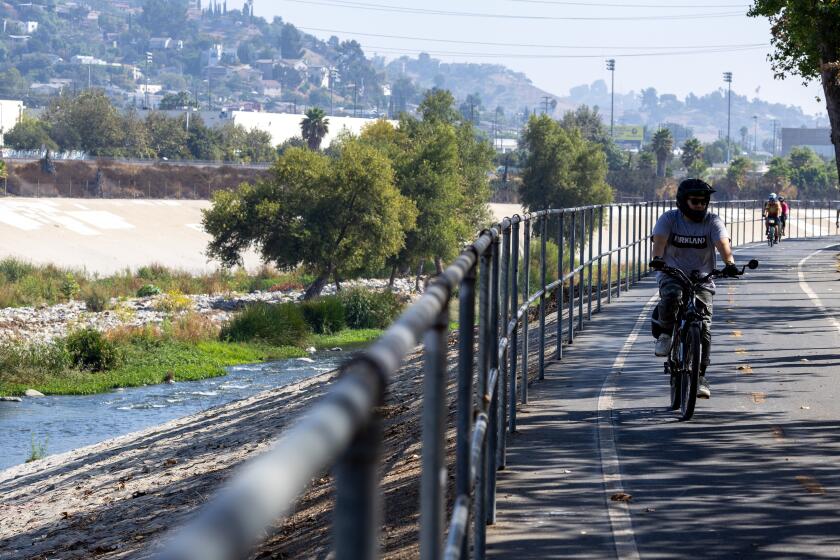Build My Figueroa, and let L.A.’s cyclists, and walkers, flourish
When I look at the renderings of My Figueroa — the city’s first “complete street” designed to equally accommodate drivers, bikers, bus riders and pedestrians — I think, “Now that would be a great walk.”
The sidewalk would be wide and lined with trees and planters. There would be new streetlights and benches. The new cycle tracks and transit islands would create a wide buffer from the rush of cars and buses, making the stroll a bit more quiet and peaceful. The four-mile stretch from Exposition Park to 7th Street would make a fine hike, taking in the sights of USC and L.A. Live.
The debate over My Figueroa has been framed as cars versus bikes. The project would remove car lanes to install about three miles of cycle tracks and a mile of buffered bike lanes — lanes separated from vehicle traffic by painted striping. Opponents are concerned the “road diet” will make traffic unbearable, and they want the Department of Transportation to redesign the project to preserve more car lanes, even if that means moving bike lanes from Figueroa.
VIDEO: Do you drive in L.A.? Watch this to see what scares cyclists.
But there hasn’t been enough focus on how a redesign would affect the other users — namely, the walkers. If the bike facilities are moved to another street, will the street lamps and lushly landscaped and buffered sidewalks go too? Will Figueroa get half a makeover? And maybe slower traffic on Figueroa isn’t such a bad thing, especially if it means fewer cars speeding through red lights as pedestrians step into the crosswalk or fewer drivers carelessly turning right without looking for walkers.
Gabe Klein, a big thinker in the mobility world who used to head transportation agencies in Chicago and Washington, recently spoke at City Hall about the need to make the streets safer for pedestrians. “We should be planning for the pedestrian first, then the transit user, the auto user and the bike user,” he said. His point, as urban planning blogger Jack Skelley noted, was that if cities design streets to be safer for pedestrians, the roads will end up being safer for everyone else too.
ALSO:
Can car-happy L.A. learn to share the road?
The 2nd Street tunnel’s frustrating bike lanes
Some advice for cyclists: Being self-righteous can be dangerous
Follow Kerry Cavanaugh on Twitter @kerrycavan and Google+
This post is part of an ongoing conversation to explore how the city’s cyclists, drivers and pedestrians share and compete for road space, and to consider policy choices that keep people safe and traffic flowing. For more: latimes.com/roadshare and #roadshareLA.
More to Read
A cure for the common opinion
Get thought-provoking perspectives with our weekly newsletter.
You may occasionally receive promotional content from the Los Angeles Times.











